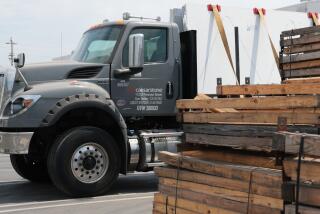Link to Lung Disease Traced to 1906, but Asbestos’ Strengths Spurred Use
- Share via
In 1906, an English physician published one of the first reports of death by asbestos, writing of “spicules of asbestos” in the lungs of a 33-year-old factory worker who died of pulmonary fibrosis.
Despite such early links to respiratory disease, the use of asbestos grew with the century. An easily mined mineral, it could be woven like cotton into a fabric that resisted flames and acids. Easily fabricated, it was tough enough to brake speeding locomotives.
“It has a tensile strength 10 times greater than steel,” said Arthur Langer, a mineralogist who teaches environmental medicine at New York’s Mount Sinai School of Medicine. “This is really some stuff.”
Dr. Irving Selikoff, a colleague of Langer at Mount Sinai and a leading expert on the health consequences of asbestos, views its utility with less enthusiasm.
“It would be a very valuable material if it didn’t kill people when they inhaled it,” he said.
About 240,000 tons of asbestos are still used in thousands of products each year. Some experts argue that asbestos in any form presents a health threat; others say the dangers are overstated. Both sides agree more research is needed to understand its properties and risks.
“We have puny data on a lot of things,” said Mark McClanahan, a health scientist at the Centers for Disease Control in Atlanta. “We can’t prove the cancer people are dying from is the result of asbestos exposure from 20 years ago.”
Asbestos is a generic term for a variety of natural compounds with tightly woven structures that provide unusual strength and flexibility.
The most commonly used asbestos is chrysotile, a white magnesium silicate mined mainly in Canada. Other commercial asbestos includes crocidolite, a blue-tinged compound, and amosite, which is brown. Both are mined in South Africa.
Although the U.S. Environmental Protection Agency considers all asbestos dangerous, Canada and the United Kingdom place tighter restrictions on blue and brown asbestos than they do on white asbestos.
Malcolm Ross, a mineralogist with the U.S. Geological Survey, said population studies show chrysotile is less of a health risk.
“There’s no non-occupational risk with chrysotile,” Ross said. “In the workplace, chrysotile should not show any noticeable increase of disease if it is controlled.”
There is little debate over the connection between illness and prolonged exposure to heavy concentrations of airborne asbestos fibers. Such exposure can lead to asbestosis, a scarring of the lungs that leaves victims gasping for breath and prey to heart failure.
Population studies show asbestos workers are five times more likely than the general population to develop lung cancer three decades or more after exposure. The risk to asbestos workers who smoke increases another fivefold.
“Smoking just pours oil on the fire,” said Selikoff.
Mesothelioma, a rare and fatal cancer of the chest and abdomen, is closely linked to asbestos exposure. Studies have shown an asbestos connection in 70% to 90% of all mesothelioma cases.
How asbestos causes disease is largely unknown. Some studies point to the size and shape of the fibers that become trapped in the lungs. Other researchers say the normal cell mechanisms that repair genetic damage are impaired by the presence of asbestos, an effect that could lead to cancer.
Dr. Melvyn Tockman, an associate professor of environmental health at Johns Hopkins University, says the body’s defenses react to asbestos in a way similar to a bacterial infection. But in the case of asbestosis, the reaction creates fibrosis, the growth of fibrous connective tissue that limits lung function.
“What isn’t fully understood is the differences about the response to asbestos fiber,” he said. “Why does this response lead to fibrosis after inhaling asbestos, as opposed to inhaling the organisms that cause routine pneumonia?”
Early health studies focused on the risks faced by asbestos miners and millworkers, a relatively small group. Research begun by Selikoff and others in the 1950s linked asbestos to sickness in shipyard workers, construction workers and other occupations that used asbestos.
“For every person who made asbestos, there were 500 who used it,” said Selikoff. “That raised the ante from a small group to a very large number.”
Selikoff estimated that over the last four decades, 20 million Americans have worked in trades that use asbestos, including utility, chemical, railroad and marine workers. He said as many as 9,000 cancer deaths a year might be asbestos-related.
Today’s medical debate centers on the dangers of limited asbestos exposure. Does the asbestos in the walls and ceilings of a school present a threat to children sitting in classrooms? Do janitors and construction workers risk cancer by working in older buildings? Do they carry the hazards home to their families?
Richard Lemen, an official with the Department of Health and Human Services’ National Institute for Occupational Safety and Health, said there was danger in any exposure to asbestos.
“Even at extremely low levels people are contracting disease,” he said. “We can’t quantify the amount, but we know that people are getting sick. We know of no safe level, so the only way to eliminate all risk is to eliminate all use.”
But some question the level of risk. Dr. Hans Weill, a Tulane Medical School professor and researcher on occupational lung disease, said mathematical models predict that schoolchildren exposed to small amounts of asbestos over six years face the risk of five deaths per million over their lifetime.
By comparison, high school football players face a death rate of 10 per million annually; bicycle riders face a death rate of 15 per million annually. Weill wonders, given those figures, if money spent to remove all asbestos would be well spent.
“Is that a good use of potentially billions of dollars of resources?” he asked. “Couldn’t we save more lives by doing something else?”
With the prospect of a ban on new asbestos products, manufacturers are going after the $100-million market with substitutes, from natural clays to synthetics.
Du Pont touts two synthetics: Kelvar, to replace asbestos in brake pads, gaskets, sealants and adhesives; and Nomex, for fireproof clothing.
The replacements are not cheap. Kelvar brake pads cost four times more than asbestos pads.
In addition, Langer of Mount Sinai worries that some asbestos replacements may themselves pose undiscovered health risks, noting that little research has been done on their biological effects.
“In order to produce something as good as asbestos, we have to reproduce its qualities. Why should their biological properties be any different?” he said.
More to Read
Sign up for Essential California
The most important California stories and recommendations in your inbox every morning.
You may occasionally receive promotional content from the Los Angeles Times.













